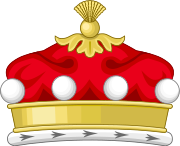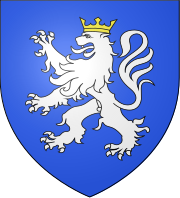Lord of Galloway
This articleneeds additional citations forverification.(November 2009) |
  |
Thelords of Gallowayconsisted of a dynasty of heirs who were lords (or kings) and ladies who ruled overGallowayin southwest Scotland, mainly during theHigh Middle Ages.Many regions of Scotland, including Galloway andMoray,periodically had kings or subkings, similar to those in Ireland during theMiddle Ages.The Scottish monarch was seen as being similar to ahigh king(Ard-RighinGaelic). The lords of Galloway would have either paid tribute to the Scottish monarch, or at other times ignored him. The Lords of Galloway are fairly well recorded in the 12th and 13th centuries, but the records are incomplete or conflicting at other times. Later on, the kings were known as "lords" at the Scottish court, and "kings" at home, finally becoming "lords" in both arenas.
The boundaries of the Kingdom of Galloway were ill-defined, and varied over time. During many periods Galloway was much larger than it is today, and took in parts of southernAyrshire,such asCarrick,Upper Douglasdale andNithsdale.The area appears to have been the main bastion ofScottish Gaelicculture south of theHighlandsin theMiddle Ages.
Kingdom of Galloway[edit]
Suibne mac Cináeda(d.1034) is the first recorded king of theGall-ghàidhil,the people of Galloway, although it is not until about 1138 that the succession is properly recorded. The Dynasty of Fergus appears to have continued until 1234 and the Laws of Galloway remained in force until 1426. It is thought that these laws originally derived their authority from the kings of Galloway.
Contrary to some popular conceptions, there is no evidence that Galloway was ever part of theKingdom of Strathclyde.It does not logically follow from that that Galloway (west of theNithat least) lay outside the traditional area claimed by theKingdom of Alba,Strathclyde'ssuccessor statein the area. Galloway, often defined as all of the area to the south and west of theClydeand west of theRiver Annan,acknowledged the kings of Scotland as Ard Rí or over-king when politic. The year before his death, Fergus resigned Galloway into the hands ofKing Mael Coluim IV of Scotland.Though it formed part of the northern mainland of Britain, Galloway was just as much a part of the Irish Sea; part of that Hiberno-Norse world of theGall-Gaidhellords of theIsle of Man,Dublinand theHebrides.The ex-King of Dublin and Man,Echmarcach mac Ragnaill,had the titleRex Innarenn(possibly "King of the Rhinns") attributed to him on his death in 1065. The western sections of Galloway had been firmly aligned with the Isle of Man, and Norse and Gaelic-Norse settlement names from the 10th and 11th centuries are spread all along the coastal lands of south-western" Scotland "and north-western" England ".
Magnus III[edit]
In the late 11th century, the Norwegian KingMagnus III Berrføtt( "Barefoot" ) led a campaign of subjugation in the Irish Sea area. In 1097, he sent his vassal,Ingimundr,to take control of the Kingdom of the Isles. However, when this man was killed, Magnus himself launched the first of his two invasions, the campaigns of 1098-1099 and of 1102-1103. In the former campaign, he took control of theWestern Islesof Scotland, and deposed KingLagmannof Man. (Incidentally, this campaign also brought him to Wales, where he killedthe Earl of Chesterandthe Earl of Shrewsbury,who were at war withthe Prince of Gwynedd.) In this campaign, Magnus almost certainly brought Galloway under his suzerainty too. Magnus, moreover, gained the recognition of these conquests from the then-king ofAlba,Etgair mac Maíl Coluim.
On his second campaign, Magnus went to Man, and with a huge fleet attacked Dublin and attempted to force the submission ofMuircertach mac Toirrdelbach,theUí BriainKing ofMunster.The campaign resulted in an alliance between the two kings, and the arranged marriage of Magnus' sonSiguðrto Muircertach's daughterBjaðmunjo.The alliance mitigated the threat ofDomnall Ua Lochlainn,King ofAilech,bringing stability to the Irish Sea world, and security to Magnus' new Irish Sea "Empire." However, it all went wrong when Magnus was killed on his way back to Norway on a minor raid inUlster.Much of Magnus' work lay in ruins.
Fergusan Dynasty[edit]

Fergus of Gallowaytook the throne of Galloway some time between 1110 and 1120. When he died in 1161 the year after taking canonical habit in Holyrood, according to the Chronicle of Holyrood, and resigning Galloway to Scotland’s King Mael Coluim IV, Galloway was left to his two sons,UchtredandGille Brigte(Gilbert). In 1174 Uchtred died after being brutally blinded and mutilated by his brother Gille Brigte and Gille Brigte's son, Máel Coluim (Malcolm). When Gilla Brigte died a few years later, in a meeting between the kings of Scotland and England and the two sons of Uchtred and Gille Brigte, it was agreed that Uchtred's sonLochlann(Roland) would take possession of the southern part of Galloway. Gilla Brigte's surviving sonDonnchad(Duncan) was given the northern part, being made1st Earl/Mormaer of Carrick.
Lochlann married Helen, the daughter ofRichard de Moreville,Constable of Scotland,and inherited his father-in-law's title. Their sonAlan of Gallowaywas the most powerful of the lords and upon his death in 1234, his holdings were divided between his three daughters and their husbands. However, an attempt was made, within Galloway, to establish Alan's illegitimate sonThomasas ruler, but this failed when KingAlexander II of Scotlandbroke the line of rejected such claim for an illegitimate son to take over. In response,Gille Ruadhled a revolt against Alexander. The attempt failed resulting in Galloway being divided amongst Alan's three living daughters who were married to Anglo-Normans,Roger de Quincy(married toEla),John de Balliol(married toDerborgaill) andWilliam de Forz(married toCairistiona). Galloway's period as an independent political entity eventually came to an end with John de Balliol delegated as Lord.
Douglas Lords[edit]
In 1369,Archibald the Grimhad been appointed Lord of Galloway byDavid II of Scotland,"becaus he tuke git trawell to purge the cuntrey of Englis blude". Later he would construct his mighty fortress ofThrieve,near present-dayCastle Douglas.
- Archibald Douglas, Lord of Galloway
- Archibald Douglas Lord of Galloway
- Archibald Douglas, Lord of Galloway
- Margaret Douglas, Fair Maid of Galloway
List of Lords of Galloway[edit]
| Rulers | French name | Reigns |
|---|---|---|
| ?Suibne | --- | d. 1034 |
| - | --- | - |
| ?Echmarcach | --- | d. 1065 |
| - | --- | - |
| Fergus | --- | d. 1161 |
| Uchtred | --- | 1161–1174 |
| Gille Brigte | Gilbert | 1174–1185 |
| Lochlann | Roland | 1185–1200 |
| Alan | --- | 1200–1234 |
Notes[edit]
- ^The Gallovidian regions arethe Rhinns,Farines,the Glenkens,Desnesmor,andDesnes Ioan.
References[edit]
- ^Scott, JG (1997)pp. 13a fig. 1, 23 fig. 5;Oram, RD (1991)p. 118 fig. 8.1;Barrow (1980)p. 51.
- The Arms of the Realm and Ancient Local Principalities of Scotland,Bartholomew 1983.ISBN0-7028-1709-0

